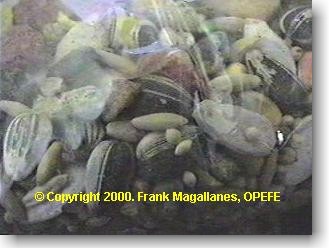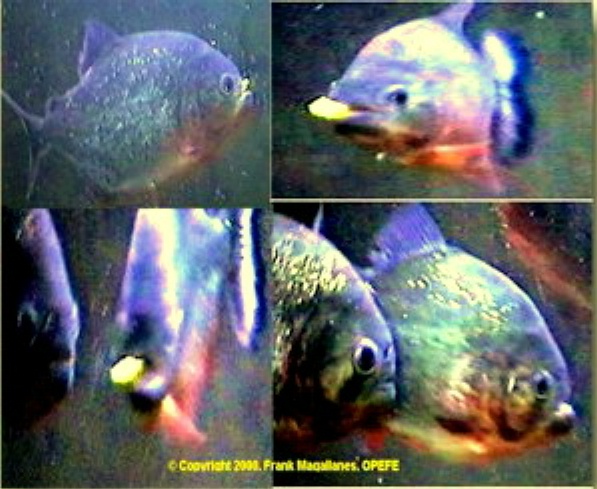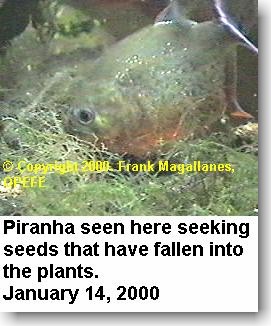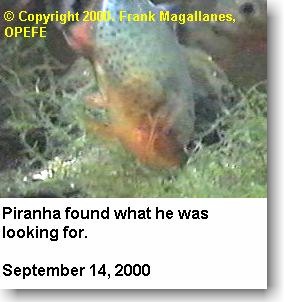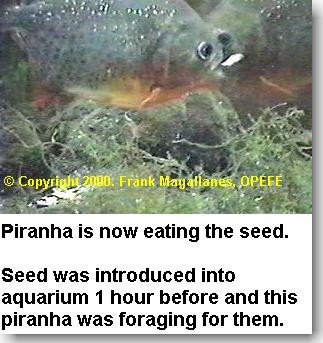|
The focus of this research is Pygocentrus nattereri, commonly called the red-bellied piranha. The genus Pygocentrus of which there are 3 species; cariba, piraya and nattereri (Fink, 1993) have only recently been examined in the wild to determine their actual food requirements. Only cariba has been researched thus far in this genus (Machado-Allison and Garcia, 1986; Machado-Allison, 1987; Nico and Taphorn, 1988 through personal observations).
The specimens used for this experiment are; 2 large adults measuring approximately 155 mm SL; 11 smaller juveniles measuring 50 mm SL to 100 mm SL. These piranhas are kept in a 90 gallon aquarium and have been raised on cut, frozen shrimp, beef heart, live bluegill (Lepomis), live goldfish (Carassius) and Dora-Red by Tetra-Min. The large adults are approximately 2 years of age and the juveniles age is approximately 6 months old at the start of this experiment.
The above image is (left) the bag of seed mix and (right) the actual seed mix fed to piranhas. Note how each frame shows piranhas fighting for seeds. The large adults were not shy about trying to take away this piece of nut from its relative, the last photo shows an actual adult attempting to "steal" the nut away from its relative.
I have included an image of the seed mix purchased from a local pet store. I isolated the grain, nuts and fruit from the dry mixture. The dry mixture appears to be ground up chicken and other animal parts according to the pet store where it was purchased. The seeds are common mix associated with parakeets and finches. Included in this mix that I was able to identify is pumpkin seeds, sunflower seeds, dry banana, dry tangerine wedges, dry lemon wedges.
THE EXPERIMENT - August 4, 2000
I began the experiment on August 4, 2000. Since I was attempting to approximate the dry season, I allowed the aquarium to drop down in water level for 5 days. The piranhas were not fed during this period of time and then I raised the water level using cold water. This fluctuated the aquarium temperature (normally 82F to 78F) causing the piranhas to be more active (pre-breeding behavior was seen, i.e. tail fin slapping and mouth open/gill flaring display). At first the piranhas ignored the seeds, with some of young piranhas "tasting" the seeds but spitting it out, until it finally sank to the bottom. Several hours later, 2 juvenile piranhas were seen to actively seek out the seeds on the bottom of the tank. It appears hunger was the driving force. The evening of the 6th, I added more seeds and the entire group began to eat it. Since some of the fruits (wedges) were of a dry nature, the piranhas ignored them until they became saturated with water. As these wedges fell from the surface the larger adults began to eat them. By the 8th day, all the piranhas were actively eating seeds, fruits and the nuts. They were even feeding off the surface as the mix was introduced until fights would break out over certain nuts. The adults in particular were interested in the dry bananas often waiting for the banana to be soft enough before eating it. If another smaller piranha became interested in this meal, the larger adult would snap it up and flee with it to another part of the aquarium. There the fish would "mouth" the nut until it appeared to me to be tender enough for the fish to matriculate it, then swallow.
August 15, 2000
The adult fish are no longer accepting the seeds, largely ignoring it. They do however investigate when the younger juveniles go on their feeding frenzy. The young fish are still accepting the seed mix.
August 18, 2000
I watched for any indication from the gills if any of the mix was expelled. So far so good, the younger piranhas are feeding on the seeds, but the other two larger adults do not seem to be interested in the seeds. I fed a large cube (50 mm square) of raw beef heart and the fishes were in a feeding frenzy. I added more seeds and they all began to eat it including the adults. I note over the years of keeping piranhas that they will attempt to eat certain things but if they do not like it they expel it from the gills as it is chewed up. I did not see this except with the pumpkin seeds, the piranhas did not like it. Subsequent attempts to feed this type of seed failed and I had to remove the undigested and uneaten from the top of the aquarium. They continue to feed on seeds and I fed one more additional cube of raw beef heart. I plan to feed no more beef heart and monitor if the adults feed on any seeds that the younger piranha had not eaten.
September 3, 2000
The bottom of the aquarium is free of uneaten seeds. They appear to forage for seeds that are lost in the plants. No seed particles are found in the filtration system and the only uneaten seeds still seem to be the melon and pumpkin seeds.
September 5, 2000
Entering information collected today. The piranhas have not been fed anything else additional except from the seed packet. Adults now are feeding on larger seeds, not sure what they are. Some corn was taken and eaten by juveniles. Had not seen this before. Noted one piranha was bitten on right flank. Will use this specimen for continuation of research information on the topic Piranha Body Bites. No other piranha has this type of bite and may have resulted when they were fighting over some larger seeds. They go into a feeding frenzy each time seeds are introduced. The seeds that follow to the bottom are later scavenged by the younger piranha. Fishes were fed a large chunk of beef heart (6 inch x 2 inches thick) to keep the protein in their diet. Feeding frenzy was spectacular with the fishes actually splashing the surface of the aquarium like a Frank Buck wild animal movie.
September 8, 2000
The two adult piranhas are still not accepting any more seeds. They may still be full from the large chunk of beef heart they were fed on September 5. Juveniles are still feeding on seeds. I have seen some changes in their coloration but will wait until I can better clarify this remark. The experiment is still to early and incomplete to produce a hypothesis.
September 9, 2000
The piranhas were not fed today. The entire group (including adults) were seen picking up seeds from the bottom of the aquarium. It seems they have taken a liking to the dry corn. This may not be unusual since "corn meal" is part of many dry fish foods. So there might be a good connection for this hypothesis. September 10, still have not fed the piranhas any seeds and they are still seeking the remaining seeds from the bottom of the aquarium including taking them from the plants that are partially hidden. I notice that more of the piranhas are suffering fin bits and some body scrapes. Tomorrow I will introduce more seeds.
September 11, 2000
The piranhas have not been fed as of yet. I decided to let them go another day and simply use the time to observe them more closely while they interact with one another. It is now September 12, I will be feeding the piranhas more seeds and nuts just before midnight. This way I can observe how well they have done without food. They tend to go into a feeding frenzy with the more larger piranhas quickly taking the pieces of seeds they prefer. I am getting a better idea of what they like and dislike. Particularly what they go after once everyone settles down. I will continue observations and post additional images in the next day or two.
September 13, 2000
Decided to go a bit longer without feeding them. The piranhas are still foraging on the bottom of the aquarium. I plan to photograph them and post tomorrow. Some scrapes noted on the body of some of the younger piranha, but no indication if this is the result of fighting or scraping themselves as they avoid each other's aggressive advances.
September 14, 2000
Fed the piranhas more seeds and pieces of nuts. Since today is Thursday's is feeder fish pickup day. I will introduce some of these to the piranhas. In the meantime, I have photographed a piranha foraging for seeds and nuts among the plants.
Sequence of events are illustrated on these four photographs of Pygocentrus nattereri foraging for nuts and seeds. As you can see from the photograph the piranha has been eating its fill of this diet.
300 Feeder goldfish were introduced and they were quickly dispatched. It is now evening (2205 hrs.) I will be posting this information for the latest round of updates.
September 15, 2000
It is now 1145, dead feeder fish were given to the piranhas (200) which were quickly dispatched. I plan no other feeding of dead fish for the next couple of days. This will afford me the opportunity to evaluate whether or not they will continue to accept the seed mixture or ignore it since I have started them on piscivorous meal. No further remarks will follow until September 19, 2000. This will allow time to restart the experiment. I plan to do a 30% water change and feed them seeds later in the day of the 19th. Belly color of the piranhas are fluorescent pink. Very strange color for this species of piranha.
September 19, 2000
Water change was done and the piranhas did quite a bit of fin biting while "bunching up" together. There was a few scrapes on the body and head from the dashing and running into some rocks that were placed in the aquarium as decoration. Other than that, they are fine. I introduced some seeds and none were eaten. This was after a couple hours after the water change. Later in evening, they were seen to be scavenging them from the bottom of the tank and some were taking them off the plants.
September 22, 2000
The seed feeding has continued and now the fish are eating the seeds much more enthusiastically. I introduced some dead goldfish and they were quickly dispatched. I am reluctant to just feed seeds on a continual basis without at least introducing some fish to supplement their diet. The color of the belly is still very strange. More yellow is appearing with pink still present. I have no real opinion if the color will become more pronounced or if it is the effect of the grains they are being fed. Certain Pygocentrus species from Rio Sao Francisco (piraya), Orinoco (cariba) and Paraguay (nattereri) have bright yellow bellies, but I don't know if this is any way connected with their eating wild grain/seed. No real studies as I have noted at the beginning has confirmed this yet. The piranhas in this aquarium have not appeared to have lost any muscle mass. Appear to be quite healthy other than the few bites to fins, scrapes and the single dorsum bite that I have been discussing elsewhere at this web site. The larger adults of which concerned me in the beginning of this experiment are still looking in good health and seem to be attracted more to the corn and larger pieces of walnuts which they quickly cut into smaller pieces before ingesting.
September 30, 2000
I allowed several days to go by without feeding piranhas. I wanted to see if they would forage the bottom of the aquarium for any uneaten seeds. They did forage. Earlier I had mentioned that the belly color of the piranhas was appearing strange. Below is an image taken just today to highlight this color.
Though the image is marked as "yellow belly" a few have developed yellow in the rear area of the belly (distally from the anal fin anteriorly). Florescent reddish-orange with a highlight of pink seems to predominate the belly region. These fish before the seed feeding started had bright red bellies. It is this reasoning that causes me to hypothesize that diet does play an important factor on what the belly color will be. Perhaps in the areas where belly color is intermixed it is the diet which influences these colors. Fishes from the Paraguay region (Southern most populations) have bright yellow bellies. It could be those fishes are ingesting some seed or vegetative matter that produces that particular belly color.
For now this concludes the Seed-feeding of Pygocentrus nattereri. I would hope that someone else would pickup where I ended on this research information. - Frank Magallanes, OPEFE, September 30, 2000
REFERENCES
-
Machado-Allison, A., y Fink, William L., Los Peces Caribes de Venezuela, Diagnosis, Claves, Aspectos Ecologicos Y Evolutivos, p.98, 1996.
USE YOUR BACKSPACE TO RETURN OR CLICK HERE TO RETURN RESEARCH PAGE
TO RETURN HOME CLICK HERE
The OPEFE web site and its contents; is disclaimed for purposes of Zoological Nomenclature in accordance with the International Code of Zoological Nomenclature, Fourth Edition, Article 8.3 and 8.4. No new names or nomenclature changes are available from statements at this web site.
Copyrightę 1994-2012 Oregon Piranha Exotic Fish Exhibit (The OPEFE fish exhibit is permanently CLOSED as of 2000) Sutherlin, Oregon. Information posted on this web site is archival data on fish scientific classifications and other information. DISCLAIMER: The copyrighted material may not be used for any purpose other than private study, scholarship or research. Cited information requires credit and this link www.opefe.com. All rights reserved. All images shown (unless otherwise noted) is property of OPEFE.
